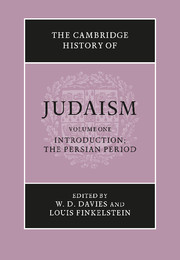Book contents
- Frontmatter
- INTRODUCTION
- THE PERSIAN PERIOD
- 4 The Persian empire and the political and social history of Palestine in the Persian period
- 5 The archeology of Persian palestine
- 6 Hebrew and Aramaic in the Persian period
- 7 The Jewish community in Palestine in the Persian period
- 8 Prophecy and Psalms in the Persian period
- 9 Wisdom literature in the Persian period
- 10 Jewish religious life in the Persian period
- 11 Persian religion in the Achemenid age
- 12 Iranian influence on Judaism: first century B.C.E. to second century C.E.
- 13 The Diaspora
- Bibliographies
- Chronological Table
- Index
- References
8 - Prophecy and Psalms in the Persian period
from THE PERSIAN PERIOD
Published online by Cambridge University Press: 28 March 2008
- Frontmatter
- INTRODUCTION
- THE PERSIAN PERIOD
- 4 The Persian empire and the political and social history of Palestine in the Persian period
- 5 The archeology of Persian palestine
- 6 Hebrew and Aramaic in the Persian period
- 7 The Jewish community in Palestine in the Persian period
- 8 Prophecy and Psalms in the Persian period
- 9 Wisdom literature in the Persian period
- 10 Jewish religious life in the Persian period
- 11 Persian religion in the Achemenid age
- 12 Iranian influence on Judaism: first century B.C.E. to second century C.E.
- 13 The Diaspora
- Bibliographies
- Chronological Table
- Index
- References
Summary
An account of the prophecy and Psalms of the Persian period – that is, the two hundred years of Persian rule over Palestine from 538 to 330 b.c.e. – is fraught with the same difficulties as any other history of prophecy and Psalms within a given period. The problems arise first from the peculiar way in which the literature of the Old Testament psalmists and prophets was handed down, and secondly from the particular circumstances in which the literature of prayer came to be written.
Thus in the first instance written prophecies and prophetic testimonies were rapidly collected into small anthologies; these were then put together to form larger collections and whole books. In the course of this anthologizing process, what were originally anonymous prophetic utterances were very frequently attributed to named prophets, either because within the oral tradition the sayings of well-known prophets had already been enriched by the addition of anonymous material, or because an attempt was made thereby to give authority to anonymous utterances as pseudo-epigraphic literature. The result of this whole process is that most prophetic books represent, not the sole product of a single author, but a complicated tapestry of utterances from a variety of sources. This means that scholars have to deal with an abundance of anonymous and pseudo-epigraphic texts which can be dated and placed in historical order only through an indirect approach. We must find and interpret evidence that will help us place the texts in the right order and we must produce arguments to establish which indeed are the pseudo-epigraphic texts.
- Type
- Chapter
- Information
- The Cambridge History of Judaism , pp. 162 - 188Publisher: Cambridge University PressPrint publication year: 1984



